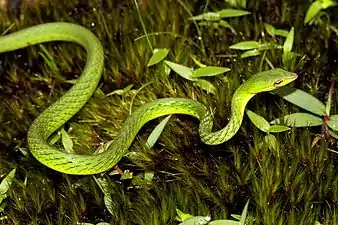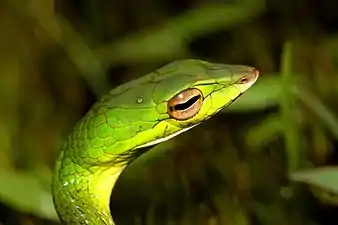Ahaetulla dispar
Ahaetulla dispar, the Gunther's vine snake, is a species of tree snake endemic to the Western Ghats. It is primarily restricted to the Shola forests of the Southern Western Ghats where it is found often on high-elevation montane grasslands and the low shrub belts.
| Gunther's vine snake | |
|---|---|
 | |
| Scientific classification | |
| Kingdom: | Animalia |
| Phylum: | Chordata |
| Class: | Reptilia |
| Order: | Squamata |
| Suborder: | Serpentes |
| Family: | Colubridae |
| Genus: | Ahaetulla |
| Species: | A. dispar |
| Binomial name | |
| Ahaetulla dispar (Günther, 1864) | |
| Synonyms | |
| |

Description
Snout pointed and projecting, without dermal appendage, not quite twice as long as the eye. Internasals and prefrontals usually in contact with the labials; one or two small loreals ; frontal as long as its distance from the end of the snout or longer, oa long as the parietals; one preocular, in contact with the frontal, with one or two suboculara below; twopostoculars; temporals 2+2 or 2+3; upper labials 8, fifth entering the eye; 4 lower labials in contact with the anterior chin-shields, which are as long as the posterior or a little shorter. Scales in 15 rows, those of the sacral region more or less distinctly keeled. Ventrals 142-151; anal divided; sub-caudals 90-105. Bright green or bronzy olive above, the skin between the scales black; pale green or pale olive beneath, with a yellow line on each side.[2] Total length 26 inches; tail 7.5.
Geographic Range
It is endemic to Southern Western Ghats in Kerala and Tamil Nadu states of South India, from the Anaimalai Hills to the region north of the Shencottah Gap. Precise records are from Munnar, Anaimalai, Grass Hills National Park, Palni hills, Meghamalai, Periyar Tiger Reserve, and Travancore hills. Populations south of the Shencottah Gap, in regions such as the Agasthyamalai Hills, are now considered to belong to a separate species, A. travancorica. It is a high-elevation species, occurring only above 1300 m, all the way up to 2695 m asl.[3]
Habits and habitat
It is a diurnal, semi arboreal and sometimes terrestrial snake. Males are often green, while females are brown. It mainly feeds mainly on lizards and frogs. It is considered to have a mild venom and is rear-fanged. It is presumed to be ovoviviparous, giving birth to live young ones. Natural history poorly known.
Notes
- Srinivasulu, C.; Srinivasulu, B.; Achyuthan, N.S. & Mohapatra, P. (2013). "Ahaetulla dispar". IUCN Red List of Threatened Species. 2013: e.T172589A1347499. doi:10.2305/IUCN.UK.2013-1.RLTS.T172589A1347499.en.
- Boulenger, G. A. 1890. Fauna of British India. Reptilia and Batrachia.
- Mallik, Ashok Kumar; Srikanthan, Achyuthan N.; Pal, Saunak P.; D’souza, Princia Margaret; Shanker, Kartik; Ganesh, Sumaithangi Rajagopalan (6 November 2020). "Disentangling vines: a study of morphological crypsis and genetic divergence in vine snakes (Squamata: Colubridae: Ahaetulla ) with the description of five new species from Peninsular India". Zootaxa. 4874 (1): 1–62. doi:10.11646/zootaxa.4874.1.1. ISSN 1175-5334.
References
- Boulenger, George A. 1890 The Fauna of British India, Including Ceylon and Burma. Reptilia and Batrachia. Taylor & Francis, London, xviii, 541 pp.
- Günther, A. 1864 The Reptiles of British India. London (Taylor & Francis), xxvii + 452 pp.
- Chandramouli, S. R., & Ganesh, S. R. (2011). Herpetofauna of southern Western Ghats, India–reinvestigated after decades. TAPROBANICA: The Journal of Asian Biodiversity, 2(2).
- Ganesh, S. R., Bhupathy, S., David, P., Sathishkumar, N., & Srinivas, G. (2014). Snake fauna of High Wavy Mountains, Western Ghats, India: species richness, status, and distribution pattern. Russian Journal of Herpetology, 21(1), 53–64.
External links
| Wikimedia Commons has media related to Ahaetulla dispar. |
- Ahaetulla dispar at the Reptarium.cz Reptile Database
- https://web.archive.org/web/20051229232916/http://www.strangeark.com/ebooks/IndiaHerps.pdf
